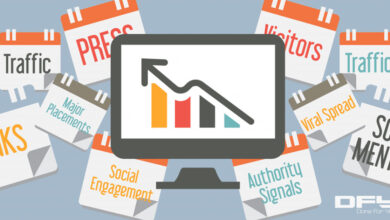Social Media Traffic Tracking: A Guide to Understanding and Optimizing Your Online Presence
In today’s digital landscape, social websites is more than merely a platform for sharing photos and opinions—it's a crucial channel for getting visitors to websites and converting visitors into customers. To harness its full potential, businesses and marketers must track and analyze track social media traffic effectively. What Is Social Media Traffic Tracking? Social media traffic tracking means process of monitoring and analyzing how users arrive at your website from social websites platforms like Facebook, Instagram, LinkedIn, Twitter (X), TikTok, yet others. It helps determine the performance of one's social campaigns, identify which platforms drive one of the most valuable traffic, and uncover opportunities for growth.  Why Is It Important? Measure ROI: See if your time and efforts on social websites are generating website visits, leads, or sales. Optimize Campaigns: Understand which posts, ads, or platforms are performing best. Understand Your Audience: Get demographic and behavioral data about your social networking visitors. Improve Content Strategy: Focus on the content types that drive the most engagement and traffic. Key Metrics to Track To evaluate social websites traffic effectively, take notice of the following metrics: Traffic Sources: Know which platforms (e.g., Instagram, Facebook) are bringing in probably the most visitors. Referral Path: See the specific posts or campaigns that drove traffic. Sessions and Pageviews: Monitor how many visits result from social platforms. Bounce Rate: Learn how engaging your website landing page is for social users. Conversion Rate: Understand the amount of of these visitors do something (purchase, subscribe, etc.). Average Session Duration: See how long users from social networking spend on your web site. Tools for Tracking Social Media Traffic Google Analytics (GA4) Track social referrals under Traffic acquisition > Session source/medium. Use UTM parameters to label links and distinguish between campaigns. Monitor conversions from social sources. Meta Business Suite (for Facebook & Instagram) Provides insights into clicks, engagement, and how much traffic your articles drives. LinkedIn Campaign Manager / Twitter Analytics / TikTok Analytics Track the performance of paid and organic content. Social Media Management Tools Tools like Hootsuite, Buffer, and Sprout Social offer integrated analytics that tie traffic and engagement together. How to Use UTM Parameters for Better Tracking UTM (Urchin Tracking Module) parameters are tags combined with the end of URLs to trace the effectiveness of campaigns. Best practices: Be in line with naming conventions. Always tag your links when posting externally. Use URL shorteners if required to keep links clean. Tips to Improve Social Media Traffic Post as soon as your audience is most active. Use compelling visuals and CTAs (calls to action). Leverage stories and reels to advertise blog content or offers. Engage together with your audience to further improve organic reach. Promote evergreen content to keep up consistent traffic flow. Tracking social media marketing traffic isn’t nearly knowing what number of people clicked a link—it’s about understanding behavior, optimizing content, and driving meaningful business outcomes. With the right tools and approach, you can turn your social channels into powerful, data-driven traffic sources that give rise to your net profit.
Why Is It Important? Measure ROI: See if your time and efforts on social websites are generating website visits, leads, or sales. Optimize Campaigns: Understand which posts, ads, or platforms are performing best. Understand Your Audience: Get demographic and behavioral data about your social networking visitors. Improve Content Strategy: Focus on the content types that drive the most engagement and traffic. Key Metrics to Track To evaluate social websites traffic effectively, take notice of the following metrics: Traffic Sources: Know which platforms (e.g., Instagram, Facebook) are bringing in probably the most visitors. Referral Path: See the specific posts or campaigns that drove traffic. Sessions and Pageviews: Monitor how many visits result from social platforms. Bounce Rate: Learn how engaging your website landing page is for social users. Conversion Rate: Understand the amount of of these visitors do something (purchase, subscribe, etc.). Average Session Duration: See how long users from social networking spend on your web site. Tools for Tracking Social Media Traffic Google Analytics (GA4) Track social referrals under Traffic acquisition > Session source/medium. Use UTM parameters to label links and distinguish between campaigns. Monitor conversions from social sources. Meta Business Suite (for Facebook & Instagram) Provides insights into clicks, engagement, and how much traffic your articles drives. LinkedIn Campaign Manager / Twitter Analytics / TikTok Analytics Track the performance of paid and organic content. Social Media Management Tools Tools like Hootsuite, Buffer, and Sprout Social offer integrated analytics that tie traffic and engagement together. How to Use UTM Parameters for Better Tracking UTM (Urchin Tracking Module) parameters are tags combined with the end of URLs to trace the effectiveness of campaigns. Best practices: Be in line with naming conventions. Always tag your links when posting externally. Use URL shorteners if required to keep links clean. Tips to Improve Social Media Traffic Post as soon as your audience is most active. Use compelling visuals and CTAs (calls to action). Leverage stories and reels to advertise blog content or offers. Engage together with your audience to further improve organic reach. Promote evergreen content to keep up consistent traffic flow. Tracking social media marketing traffic isn’t nearly knowing what number of people clicked a link—it’s about understanding behavior, optimizing content, and driving meaningful business outcomes. With the right tools and approach, you can turn your social channels into powerful, data-driven traffic sources that give rise to your net profit.